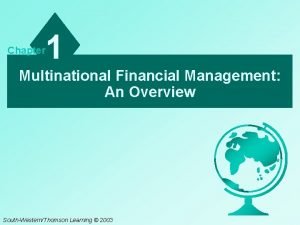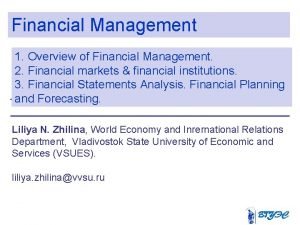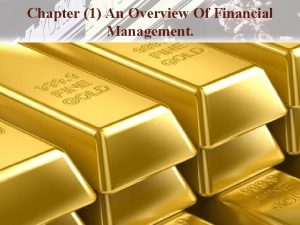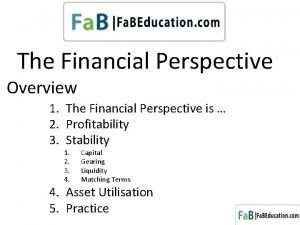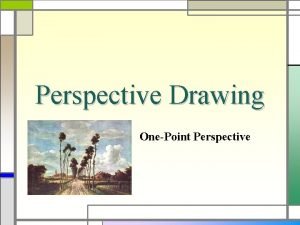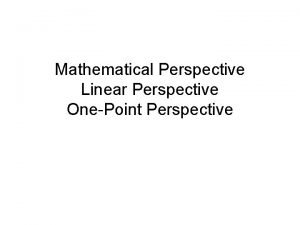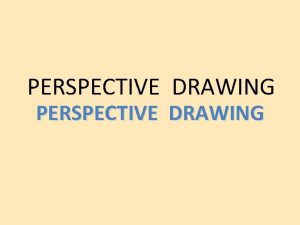The Financial Perspective Overview 1 The Financial Perspective










- Slides: 10

The Financial Perspective Overview 1. The Financial Perspective is … 2. Profitability 3. Stability 1. 2. 3. 4. Capital Gearing Liquidity Matching Terms 4. Asset Utilisation 5. Practice

The Financial Perspective Is a systematic way of using the information in the financial statements to focus on key performance goals. ❶Profitability ❷Stability (Cash and Capital) ❸Asset utilisation

Profitability Our first accounting equation Sales – Expenses = Profit Brings us neatly to the first principle of financial strategy Sales Price Volume Expenses Cost Price Utilisation ok o b k r o w p 81 in Marketing Design +++ (unlimited tactics) Management Negotiation +++ (unlimited tactics)

Stability Maintaining Stability is about making sure that the business has enough money to pay debts when due and take advantages of opportunities for growth Right first time! Staying on track Enough money to get the business up and running Maintaining liquidity Raising Capital Gearing “Long to long” Generating profits Controlling spending Credit control Planning cash flow

Stability 2 – Gearing refers to the mix of Owners’ Funds and debt used to fund the business. Debt < Owner’ Funds is Low Gearing Current Liabilities Debt ≥ Owners Funds’ is High Gearing Current Liabilities Long Term Liabilities Owners’ Funds A highly geared company would be exposed to more risk and would find further borrowing difficult: but in high profit low interest rates situations might be seen to be making better use of capital and more return to shareholders Covered in detail in “Ratios”

Stability 3 - Matching terms There a few prudent guidelines in funding a business Owners Funds Share Capital Retained Profits Fixed Assets Buildings Machinery Vehicles Long Term Loans Current Assets Current Liabilities Creditors Overdraft Stocks Debtors

Asset Utilisation Assets cost money and demand capital The principle is to keep the level of assets as low as possible without damaging target customer service levels Fixed assets Current assets Consider hiring rather than buying Be realistic about capacity against likely sales Stock control Credit control Covered in detail in “Ratios” ok o b k r o w p 81 in

se 3 i c r Exercise 3 – The Business Model Build the simple but realistic business model described in on Fa. BLinker and study the answers and practical explanations of the relevant business and financial concepts. It sets a series of challenges to introduce and explore all the financial issues managers are likely to face in the three generic key results areas: • Profit • Stability • Asset Utilisation The exercise prepares managers for the directed and self-selected smart-practice routines that will embed the financial perspective as part of their core skillset.

8 ice t c a Pr Practice 8 – Exploring sensitivity analysis Selling price = € 10 Practice 3 and complete the Sensitivity Analysis table below Buy on credit = 20 units Buy for cash = 130 units Sell on credit = 20 Sell for cash = 80 units What happens to Net profit if you improve One of the items by 10% leaving the others unchanged? Fixed overheads = € 100 Overheads paid = 100% Introduce new share capital = € 500 p 88 of n o s r e Answ book the work Old Profit = € 400 Purchase price = € 5 Draw down a new loan = € 300 Acquire new assets = € 200 Item New Profit Change % Multiplier Sales Volume Selling Prices Cost of Sales Overheads

9 e c i t rac P Practice 9 – Testing a business model Build a business model in Fa. BLinker. Test and reinforce your skills by exploring the effect which changing each of the following has on the three Key Results Areas. See if you can predict the impacts before you make each change. Selling Price Cost price Sales Volume Stock policy (buying volumes compared to sales volumes) Overhead expenses Collection times for credit sales Payment times for credit purchases Percentage of overheads paid New share capital New Loans Changes in loan interest Buy a new fixed asset Sell a fixed asset Write off a fixed asset quicker or slower (Vary depreciation charges)
 Centralized multinational financial management
Centralized multinational financial management Chapter 1 an overview of financial management
Chapter 1 an overview of financial management Overview of financial management
Overview of financial management Chapter 1 overview of financial statement analysis
Chapter 1 overview of financial statement analysis Financial intermediaries
Financial intermediaries An overview of financial management
An overview of financial management One point perspective lettering
One point perspective lettering Silo perspective vs business process perspective
Silo perspective vs business process perspective Financial perspective
Financial perspective Thế nào là hệ số cao nhất
Thế nào là hệ số cao nhất Hệ hô hấp
Hệ hô hấp
